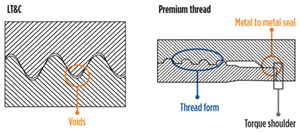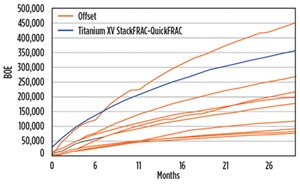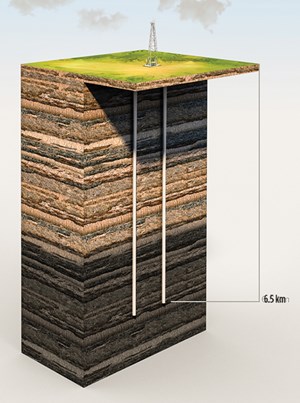Completion tool failure or an ineffective stimulation treatment can greatly impact the economic viability of a well or field development. Typically, high-pressure and/or high-temperature (HPHT) formations require a greater investment, so the risk of failure is significantly higher—requiring completion systems with a proven track record of overcoming high reservoir breakdown pressures to effectively stimulate wells, and to lower the risk of casing or other mechanical failure.

Continual improvements in completion technology have recently spurred on greater access and development in previously under-explored HPHT areas. Some well-known HPHT plays around the world include northeastern British Columbia in Canada, and offshore wells in the Gulf of Mexico, Southeast Asia, the North Sea and the Norwegian Sea. HPHT fields are also being developed in Australia and Argentina. A large offshore formation in the Persian Gulf is starting to be exploited by neighboring stakeholders, such as Saudi Arabia, Bahrain and Oman, Fig. 1.
Packers Plus Titanium XV completion solutions have been used extensively in HPHT reservoirs around the world. As this technology makes its way around the globe, HPHT tools are helping to open new opportunities while mitigating a variety of risks, including burst and collapse due to high pressure, and seal integrity due to high temperature. The capability to avoid these issues provides operators with the ability to conduct an effective stimulation for every stage of the wellbore, improving the chances of an economic well.
HPHT CHALLENGES
A primary challenge in designing HPHT completion tools is the integrity of metals. Tools must be able to function in extreme downhole conditions for at least several days, and in some cases up to several months. Elastomer degradation and failure is also a concern in HPHT environments. During stimulation, packing elements must effectively seal against the wellbore, overcoming potential damage from pipe movement, high compression loads and thermal cycling.
Vertical depths. Tools encounter higher mechanical loads and fluid friction in deeper wells, and mechanical integrity for casing and other metallic equipment generally loses significant strength, which leads to material failure at temperatures in excess of 400˚F (204˚C). Forces acting on downhole equipment also must be considered during fracturing operations, stemming from changes in temperature and differential pressure.
Bottomhole pressure variations. An overpressured zone could lead to an increase in treating pressure requirements during fracturing operations, requiring completion systems that can withstand increased differential pressures in these zones. An underpressured zone can lead to differential pressure across an isolated interval being greater than expected. It can result in a burst scenario, if a high treating pressure is required for a lower interval while an upper interval is exposed to a lower BHP.
Bottomhole temperatures. Like bottomhole pressure, high bottomhole temperatures also add stress to components, and over time this stress is compounded. Combined with H2S and CO2 gas concentrations, this can lead to increased metal corrosion in drilling and completion tools. Furthermore, a high bottomhole temperature results in large swings in temperature during stimulation, which may lead to additional mechanical stress on the tool string.
High fracture gradients. Unconventional reservoirs typically have high fracture gradients, requiring high treating pressures to initiate a fracture. Higher fracture gradients, or breakdown pressures, can sometimes result in an interval being abandoned, because the maximum treating pressure is reached prior to breakdown. Formation heterogeneity also can lead to higher-than-expected differential pressures, where each zone has a different breakdown pressure to initiate a fracture. Without downhole tools with high-pressure capabilities, this situation often can lead to tubing burst and collapse scenarios.
HPHT SOLUTIONS
To meet the needs of operators working in HPHT formations, the design requirements for Packers Plus HPHT tools include:
- Burst and collapse rating up to 15,000 psi for all components.
- Maintain pressure rating of 15,000 psi for actuation balls and sealing mechanism in the fracture port.
- Maintain thermal stability despite extreme temperature fluctuations during stimulation, using industry-standard fluids.
The resulting Titanium XV line of systems and tools was designed, based on the existing and proven ball-drop StackFRAC system, reinforced with features such as more robust metallurgy and premium seal technology, as well as premium threads.

Metal. For robust structural integrity, Titanium XV tools are made with steel that is considerably more robust than the standard 110-ksi steel used for the StackFRAC system.
Seal technology. Titanium XV tools are designed with O-rings and premium seals that have non-elastomeric backups to contain and focus elastomer extrusion.
Thread design. Since LT&C threads are not gas-tight, they are a weak link in the tool string, especially at higher pressures, and in doglegs and bend sections. Thread jumping or “zippering” are common failures when the casing is stressed with high pressures, and high tensile and compressive loads, Fig. 2.
Proprietary premium threads on Titanium XV tools have high-torque shouldered connections, with a small back angle on the face that allows for a larger surface area for torqueing. This thread is designed with a metal-to-metal seal for containment of fluid and gas, improved structural integrity, and can match or exceed the pressure rating of the tool body and the casing string.
CASE STUDIES
The Titanium XV system has been used in a variety of challenging HPHT formations around the world, including onshore and offshore wells.
Deep wells in the Duvernay. The Duvernay formation lies beneath the well-developed Montney formation in British Columbia. The depth of the Duvernay is the main challenge to its development. An open hole, ball-drop Titanium XV system, combining single-point entry StackFRAC and limited-entry QuickFRAC, was designed to complete a 31-stage well. The toe stage was opened, using a hydraulically activated FracPORT sleeve, followed by multiple Titanium XV QuickPORT sleeves for limited entry stimulation treatment in the next 24 stages. The final six stages were completed, using a single Titanium XV FracPORT sleeve for each stage.

The completion proved to be challenging. During stimulation, the treating pressure reached 11,200 psi, and 200 tonnes of proppant were placed per stage. After 16 months, cumulative gas production from the well reached 995 MMcfg, and cumulative condensate production reached 66,000 bbl—at the time, the second-highest cumulative production of all wells completed in the Duvernay, Fig. 3.
Oman. An operator working in Oman discovered that the formation being targeted was difficult to break down using standard 10,000-psi-rated equipment. To effectively stimulate the productive interval, the operator required a system with a higher-pressure rating—one robust enough to function through temperature fluctuations of more than 100˚F.
The operator required a completion system that had a working pressure of 15,000 psi, which is higher than a typical HPHT completion system. Working closely with the operator, Packers Plus made several upgrades to Titanium XV tools and testing to meet the unique standards just five weeks from the start of the design process. The final system achieved the working pressure of 15,000 psi, with a maximum pressure of 18,300 psi.
Using these tools, the operator executed a hybrid completion, using the Titanium XV system for the lower stages and plug-and-perf for the upper stages. The stimulation was completed without issue, and initial production results were encouraging.
Offshore UAE. Carbonate reservoirs such as the Shilaif reservoir in the United Arab Emirates, are typically stimulated using acid. However, one operator felt the production from its acid-treated wells could be improved and sought an alternative solution. A Packers Plus Titanium XV completion system was selected as the multi-stage HPHT technology to deliver a proppant-based completion, instead of the acid stimulation that was standard practice in the region.
A multi-stage ball-drop system was installed on a 4½-in. liner, and all eight stages of the offshore well were completed in 48 hr, in a single continuous pumping operation. Indications of proper isolation were seen from the open hole RockSEAL packers throughout the completion.
Kuwait deep carbonate. An operator working in the Northern Kuwait Gas Development Area—where most of the gas is found in highly heterogeneous, multi-layered tight and ultra-sour formations—was using conventional acid matrix stimulation of single bullhead treatments or using chemical diverters as part of the exploration phase. Production logging showed that only 10% of the total perforated intervals contributed to production.
The operator selected the field-proven StackFRAC Titanium XV system for two of its subsequent wells to increase productivity from the open hole via natural fractures, and to provide proper reservoir management in case of unwanted fluid production. Both systems were deployed successfully and set in oil-based mud (OBM) in a deep, sour environment and stimulated with acid. The wells were flow-tested using, RockSEAL H2 packers that saw downhole pressure on the order of 19,000 psi during stimulation.
Australian vertical well. The Cooper basin is one of the most significant onshore petroleum and natural gas deposits in South Australia. Downhole tools in these wells are exposed to temperatures up to 400˚F, fracture gradients as high as 1.4 psi/ft, and fracture closure stresses up to 0.9 psi/ft.
An operator planned to stimulate six cemented and pre-perforated zones over a 656-ft interval and required tools that could withstand 350˚F and 15,000 psi. Packers Plus designed a 3½-in., 6-stage StackFRAC Titanium XV system for a 7-in., cased hole, vertical well, with five drillable closeable FracPORT sleeves and one Hydraulic FracPORT sleeve at the toe of the well. The first stage was opened hydraulically to establish a flow path and communication with the reservoir, and the remaining five stages were ball-actuated and activated hydraulically to isolate and fracture the pre-perforated zones of the cased-hole wellbore.

Following the successful operation, production from the well was stabilized at 2.2 MMscfd. This cased, vertical well also led to the discovery of a new gas field in the Cooper basin. It reflects the capability of HPHT completion technology for challenging operations in shale plays.
Finnish geothermal well. A Nordic company seeking expertise from the oil and gas industry, to complete a deep vertical well to generate geothermal energy for the city of Espoo in Finland, selected a 5-stage StackFRAC Titanium XV system after two years of collaboration with multidisciplinary experts.
Based on expert recommendations from several industries, the system was designed to withstand 15,000-psi differential pressure while hydraulically stimulating the reservoir. The stimulation was designed with low pump rates and each stage being completed in five days or longer. Custom 3/8-in. seat increments were used to accommodate the lengthy stimulation of each stage, providing pressure integrity and mitigating the risk of balls degrading prior to completing the stimulation.
The geothermal well was stimulated successfully in over five weeks, with more than 150,000 bbl of water pumped. The stimulation treatment was completed entirely using cold water, enabling the actuation balls to function without incident, with maximum pressures peaking between 12,300 and 14,300 psi, Fig. 4.
CONCLUSION
Advancements in HPHT completion technology has enabled operators to develop challenging formations. Since its early development in the Duvernay formation, the Titanium XV completion system has been used extensively in HPHT reservoirs around the world.
As this technology makes its way around the globe, HPHT tools are helping to open new opportunities while mitigating a variety of risks, including burst and collapse due to high pressure, and seal integrity due to high temperature. The capability to avoid these issues provides operators with the ability to conduct an effective stimulation for every stage of the wellbore, improving the chances of an economic well. WO
- Advancing offshore decarbonization through electrification of FPSOs (March 2024)
- Shale technology: Bayesian variable pressure decline-curve analysis for shale gas wells (March 2024)
- Subsea technology- Corrosion monitoring: From failure to success (February 2024)
- U.S. oil and natural gas production hits record highs (February 2024)
- When electric meets intelligence: Powering a new era in hydraulic fracturing (January 2024)
- Driving MPD adoption with performance-enhancing technologies (January 2024)
- Applying ultra-deep LWD resistivity technology successfully in a SAGD operation (May 2019)
- Adoption of wireless intelligent completions advances (May 2019)
- Majors double down as takeaway crunch eases (April 2019)
- What’s new in well logging and formation evaluation (April 2019)
- Qualification of a 20,000-psi subsea BOP: A collaborative approach (February 2019)
- ConocoPhillips’ Greg Leveille sees rapid trajectory of technical advancement continuing (February 2019)


